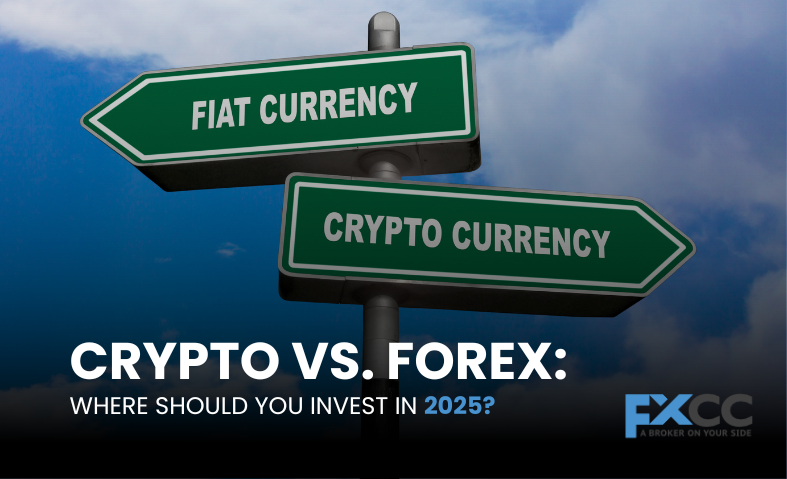The world of investing has undergone significant changes in recent years, and as 2025 unfolds, many are debating whether cryptocurrency or forex is the better choice for their financial goals. Both markets have distinct characteristics and appeal to different types of investors. Understanding these differences is crucial to making an informed decision about where to place your money.

The Rise of Cryptocurrency
Cryptocurrency has become a groundbreaking financial asset, transforming how we perceive and use money. As decentralized digital currencies, cryptocurrencies operate on blockchain technology, which ensures secure, transparent, and tamper-proof transactions. These digital assets have moved beyond their niche beginnings to become a major part of the global financial landscape.
Bitcoin, often dubbed the “digital equivalent of gold,” remains one of the most sought-after cryptocurrencies. Its limited supply and decentralized nature make it attractive to investors looking for a way to safeguard their wealth from inflation. Similarly, Ethereum has solidified its position in the market by enabling innovative applications such as decentralized finance (DeFi) and non-fungible tokens (NFTs), creating opportunities beyond just currency trading.
However, the cryptocurrency market is highly volatile. Prices can change dramatically within hours, influenced by factors such as regulatory announcements, technological advancements, and market sentiment. This makes crypto investing a double-edged sword—offering the potential for massive gains but also posing significant risks. Those considering crypto investments should be prepared for these fluctuations and stay informed about market trends and news.
Why Forex Trading Continues to Thrive
The forex market, or foreign exchange market, has long been a cornerstone of global trade and finance. It involves trading currency pairs, such as the US Dollar and the Euro (USD/EUR), making it one of the most liquid and heavily traded markets in the world. Its accessibility and transparency have kept it popular among traders of all experience levels.
A major strength of forex trading lies in its liquidity. With trillions of dollars being traded daily, the forex market allows investors to quickly buy and sell currencies without significant price changes. This liquidity makes it particularly appealing to those who prefer a more predictable and structured market environment.
Unlike the round-the-clock nature of cryptocurrency trading, the forex market operates 24 hours a day, five days a week. While this schedule is slightly more restricted, it still provides ample opportunities for traders to engage with the market during their preferred hours. Moreover, the forex market is largely influenced by global economic factors, such as central bank policies, interest rates, and geopolitical events. While these factors can make trading complex, they generally result in less dramatic price swings compared to cryptocurrency.
Crypto vs. Forex: Volatility and Risk
One of the key differences between cryptocurrency and forex lies in their levels of volatility. Cryptocurrencies are notoriously volatile, with prices capable of soaring or plummeting within a short period. This volatility presents opportunities for high returns but also increases the likelihood of significant losses. For example, a single regulatory announcement or a change in market sentiment can cause a dramatic shift in a cryptocurrency’s value.
In contrast, forex markets are relatively stable, with currencies typically experiencing smaller price movements. This stability can be an advantage for conservative investors or those who prefer a more controlled trading environment. However, forex trading often involves leverage, which allows traders to control large positions with relatively small amounts of capital. While leverage can amplify profits, it can also magnify losses, making risk management essential in forex trading.
Market Accessibility and Trading Hours
Another important consideration when choosing between crypto and forex is market accessibility. Cryptocurrency trading is available 24/7, providing unparalleled flexibility. This always-open market is particularly beneficial for those with busy schedules or who want to trade across different time zones.
Forex trading, while not available around the clock, still offers extensive accessibility. Operating 24 hours a day during the workweek, the forex market gives traders the ability to engage with it at their convenience, depending on the overlapping hours of major financial hubs such as London, New York, and Tokyo.
Long-Term Potential vs. Short-Term Gains
The long-term growth potential of cryptocurrencies is one of the main reasons they have attracted investors worldwide. As adoption grows and blockchain technology continues to evolve, digital assets such as Bitcoin and Ethereum may see significant value appreciation over time. This makes cryptocurrency an attractive option for those with a long-term outlook who are willing to ride out the market’s volatility.
Forex, on the other hand, is often preferred by those seeking short-term opportunities. Day traders and swing traders dominate this market, taking advantage of smaller price fluctuations to generate consistent profits. While long-term forex investments are possible, they are less common compared to crypto due to the relatively stable nature of currency prices.

Making the Right Choice
Choosing between cryptocurrency and forex ultimately comes down to your personal financial goals, risk tolerance, and knowledge of the markets. Cryptocurrencies are ideal for those who are comfortable with high risk, enjoy exploring cutting-edge technology, and have a long-term perspective. On the other hand, forex trading may be better suited to those who value stability, predictability, and short-term opportunities.
Before diving into either market, it’s crucial to educate yourself about their dynamics, risks, and potential rewards. Both crypto and forex have the potential to deliver strong returns, but they require different strategies and levels of commitment. By aligning your investments with your financial objectives, you can make a decision that positions you for success in 2025.


